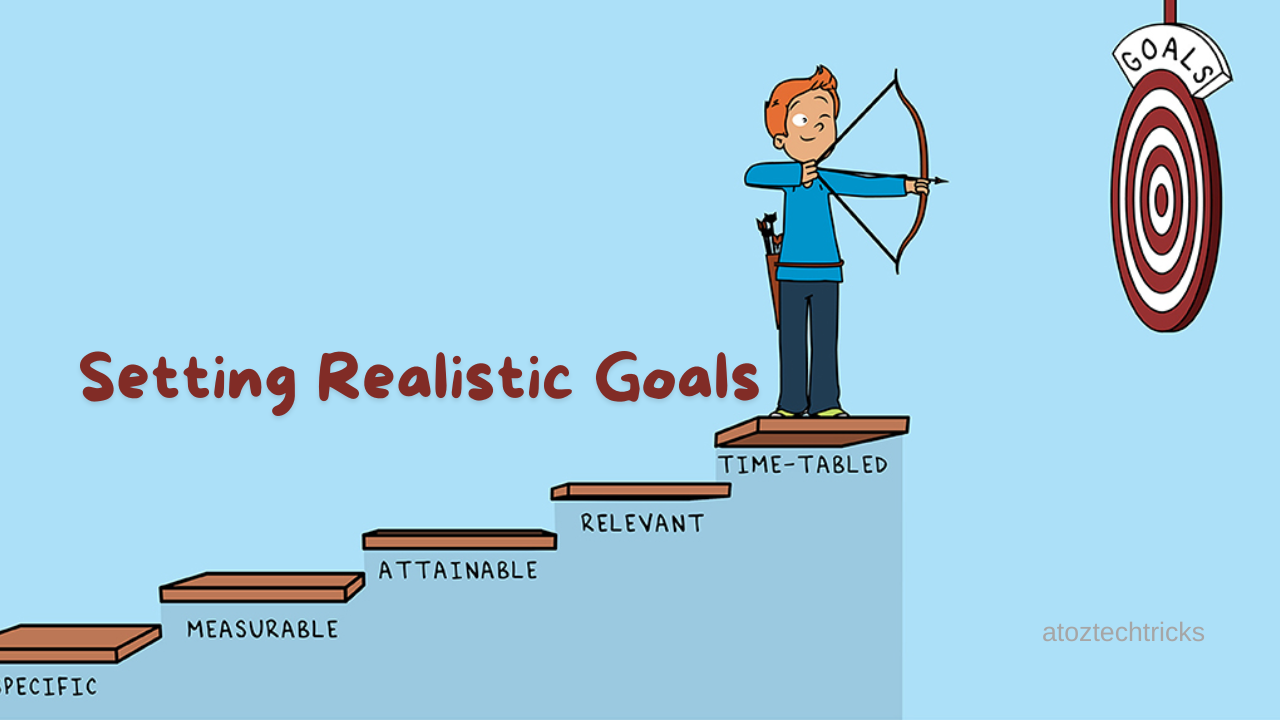Setting Realistic Goals: A Comprehensive Guide to Achieving Success
Setting goals is a fundamental aspect of personal and professional development. Whether you’re aiming for a career milestone, a fitness target, or a personal achievement, the process of setting realistic goals can significantly impact your ability to achieve them. This guide will explore the art of setting realistic goals and offering strategies and tips to help you define, plan, and reach your objectives.
Understanding the Importance of Setting Realistic Goals
Goals provide direction and purpose. They help you focus your efforts, measure your progress, and maintain motivation. However, setting unrealistic goals can lead to frustration and disappointment. Realistic goals are crucial because they ensure that your ambitions are attainable, given your current circumstances and resources. Here’s why setting realistic goals is vital:
- Clarity and Focus: Realistic goals provide clear direction and focus. They help you concentrate on what’s achievable rather than getting lost in lofty aspirations that may not be practical.
- Motivation and Engagement: Achieving realistic goals can boost your motivation and engagement. When you set goals that are within reach, you’re more likely to stay committed and enthusiastic about your progress.
- Sustainable Progress: Realistic goals promote sustainable progress. They allow you to build on small successes and gradually advance toward larger objectives without overwhelming yourself.
- Reduced Stress and Frustration: Setting achievable goals helps manage expectations and reduce stress. It prevents the frustration that comes from striving for objectives that are beyond your reach.
Financial Goal Setting: A Comprehensive Guide to Achieving Your Financial Dreams
The SMART Criteria: A Framework for Realistic Goal Setting
To ensure your goals are realistic, you can use the SMART criteria. This framework helps you create goals that are Specific, Measurable, Achievable, Relevant, and Time-bound. Here’s a breakdown of each component:
1. Specific
A goal should be clear and specific. It needs to outline exactly what you want to achieve. Vague goals like “get fit” or “improve my skills” lack clarity. Instead, specify what you want to accomplish, why it’s important, and how you plan to achieve it. For example:
- Vague Goal: Improve my fitness.
- Specific Goal: Run a 5K race in under 30 minutes by the end of three months.
2. Measurable
To track your progress, your goal should be measurable. This means defining criteria for success and quantifying your achievements. Measurable goals allow you to assess how far you’ve come and how much further you need to go. For instance:
- Non-Measurable Goal: Learn more about digital marketing.
- Measurable Goal: Complete an online digital marketing course and earn a certification within six months.
3. Achievable
A goal should be realistic and attainable, given your current resources, skills, and circumstances. It’s important to set challenging goals but ensure they are within reach. Consider factors like time, budget, and personal constraints when evaluating achievability. For example:
- Unachievable Goal: Become a professional chef in one month without prior cooking experience.
- Achievable Goal: Take a cooking class and master five new recipes in three months.
4. Relevant
Your goal should be relevant to your overall objectives and aligned with your long-term aspirations. Ensure that it’s meaningful and valuable to you and that achieving it will contribute to your broader ambitions. For example:
- Irrelevant Goal: Start a gardening hobby when you have no interest in gardening or limited space.
- Relevant Goal: Develop a professional skill that will advance your career and align with your job goals.
5. Time-bound
A goal should have a clear deadline or timeframe. This helps create a sense of urgency and prompts you to take action. Set a specific timeframe for when you want to achieve your goal and break it down into smaller milestones. For example:
- Open-Ended Goal: Write a book someday.
- Time-bound Goal: Write 500 words per day to complete a 60,000-word novel by the end of the year.

Steps to Setting and Achieving Realistic Goals
Setting realistic goals involves several key steps. Follow these guidelines to ensure you set goals that are attainable:
1. Define Your Goals
Start by clearly defining your goals. Write them down and make them as specific as possible. Consider what you want to achieve, why it matters to you, and how you plan to get there.
- Example: Instead of saying “I want to save money,” specify “I want to save $5,000 for a vacation by the end of the year.”
2. Break Down Your Goals
Large goals can be overwhelming. Break them down into smaller, manageable tasks or milestones. This makes the process more manageable and allows you to track your progress more effectively.
- Example: If your goal is to run a marathon, break it down into smaller milestones like running a certain distance each week and gradually increasing your mileage.
3. Create a Plan of Action
Develop a detailed plan of action outlining the steps you need to take to achieve your goals. Include deadlines for each step and identify the resources you’ll need.
- Example: To improve your public speaking skills, your plan might include joining a speaking club, practising weekly, and attending workshops.
4. Monitor Your Progress
Regularly review your progress toward your goals. This helps you stay on track and make adjustments if necessary. Set aside time each week or month to assess how well you’re doing and identify any obstacles you may be facing.
- Example: Track your savings progress using a budgeting app or spreadsheet to ensure you’re on track to meet your financial goal.
5. Stay Flexible and Adjust as Needed
Be prepared to adjust your goals and plans as needed. Life circumstances and priorities can change, so it’s important to remain flexible. If you encounter obstacles or find that your original goals are no longer relevant, modify them accordingly.
- Example: If an unexpected expense arises, adjust your savings plan by extending your deadline or reducing the amount you save each month.
6. Celebrate Your Achievements
Recognize and celebrate your achievements, no matter how small. Celebrating milestones boosts your motivation and reinforces positive behaviour.
- Example: If you reach a savings milestone, treat yourself to a small reward or share your success with friends and family.
Common Pitfalls to Avoid
While setting realistic goals is crucial, there are common pitfalls that can derail your progress. Here are some pitfalls to avoid:
1. Setting Overly Ambitious Goals
Ambitious goals can be inspiring but setting them too high can lead to frustration. Ensure that your goals are challenging yet achievable.
- Example: Avoid setting a goal like “Lose 50 pounds in a month.” Instead, aim for a gradual and sustainable weight loss.
2. Lack of Specificity
Vague goals are harder to achieve. Ensure that your goals are specific and clearly defined.
- Example: Instead of “Get better at time management,” set a specific goal like “Create a daily schedule and stick to it for three months.”
3. Ignoring the Importance of Planning
Without a plan, even realistic goals can become unattainable. Develop a detailed action plan and track your progress.
- Example: If your goal is to start a business, create a business plan outlining your strategy, target market, and financial projections.
4. Neglecting to Review and Adjust
Regularly review your progress and make adjustments as needed. Goals should evolve based on your progress and changing circumstances.
- Example: If you’re not meeting your savings targets, assess your budget and adjust your savings plan accordingly.
5. Underestimating the Time Required
Setting unrealistic timeframes can lead to disappointment. Ensure that your deadlines are realistic and account for potential setbacks.
- Example: Instead of aiming to complete a large project in a week, set a more realistic timeframe that allows for thorough work and unexpected delays.
![]()
Examples of Realistic Goals
Here are some examples of realistic goals to illustrate how to apply the SMART criteria:
Personal Development
- Goal: Read 12 books in a year.
- Specific: Read one book per month.
- Measurable: Track the number of books read.
- Achievable: Allocate time for reading daily or weekly.
- Relevant: Enhances knowledge and personal growth.
- Time-bound: Complete within one year.
Career Advancement
- Goal: Improve public speaking skills.
- Specific: Join a Toastmasters club and deliver at least one speech per month.
- Measurable: Track the number of speeches delivered.
- Achievable: Attend meetings and practice regularly.
- Relevant: Beneficial for career progression and confidence.
- Time-bound: Achieve noticeable improvement in six months.
Planning for Incapacitation: Ensuring Your Wishes Are Honored When You Can’t Speak for Yourself
Health and Fitness
- Goal: Run a 5K race in under 30 minutes.
- Specific: Follow a running training plan and gradually increase distance and speed.
- Measurable: Time each run and track progress.
- Achievable: Train consistently and build endurance.
- Relevant: Supports overall health and fitness goals.
- Time-bound: Complete the race within three months.
Financial Goals
- Goal: Save $2,000 for an emergency fund.
- Specific: Set aside $200 per month for ten months.
- Measurable: Monitor savings account balance.
- Achievable: Adjust the budget to accommodate savings.
- Relevant: Provides financial security and peace of mind.
- Time-bound: Reach the target within ten months.
Setting realistic goals is a crucial step in achieving personal and professional success. By applying the SMART criteria and following the steps outlined in this guide, you can define clear, achievable objectives that keep you motivated and on track. Remember to monitor your progress, stay flexible, and celebrate your achievements along the way. With a thoughtful approach to goal-setting, you’ll be well on your way to turning your aspirations into reality.





Post Comment